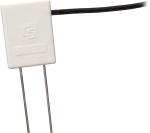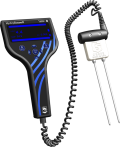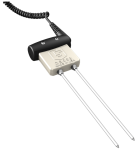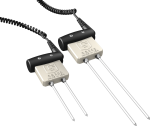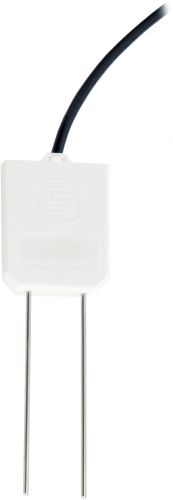
具有高批量欧共体的土壤更准确






概述
The CS655 is a multiparameter smart sensor that uses innovative techniques to monitor soil volumetric-water content, bulk electrical conductivity, and temperature. It outputs an SDI-12 signal that many of our data loggers can measure. It has shorter rods than the CS650, for use in problem soils.
Note:The cable termination options for this sensor are not suitable for use with an ET107 station. For this type of station, use theCS655.-LC传感器,具有合适的电缆连接器。
Read More福利和特色
- 较大的样本量会降低错误
- Measurement corrected for effects of soil texture and electrical conductivity
- 估计水保内容广泛的mineral soils
- Versatile sensor—measures dielectric permittivity, bulk electrical conductivity (EC), and soil temperature
Images

类似产品
详细说明
CS655由连接到印刷电路板的两个12厘米长的不锈钢棒组成。电路板封装在环氧树脂中,并且屏蔽电缆连接到电路板以进行数据记录器连接。
CS655测量传播时间,信号衰减和温度。然后介导介电常数,体积含水量和散装电导率从这些原始值衍生。
测量的信号衰减用于校正对反射检测的损耗效果,从而衡量传播时间测量。该损失效应校正允许批量EC≤8dsm的土壤中准确的水含量测量-1without performing a soil-specific calibration.
土壤散装电导率也从衰减测量计算。热接触热敏电阻与靠近环氧树脂表面的探针杆测量温度。横向安装传感器提供准确的土壤温度测量与水含量相同。在其他方向上的温度测量将是杆位入口附近的区域的环氧树脂。
Specifications
| Measurements Made | 土壤导电性(EC),相对介电常数,体积含水量(VWC),土壤温度 |
| Required Equipment | 测量系统 |
| Soil Suitability | Short rods are easy to install in hard soil. Suitable for soils with higher electrical conductivity. |
| Rods | 不可替换 |
| Sensors | Not interchangeable |
| Sensing Volume | 3600 cm3(~7.5 cm radius around each probe rod and 4.5 cm beyond the end of the rods) |
| 电磁 | CE符合要求(符合EN61326保护防止静电放电和浪涌的要求。) |
| Operating Temperature Range | -50° to +70°C |
| 传感器输出 | SDI-12; serial RS-232 |
| Warm-up Time | 3 s |
| Measurement Time | 3 ms to measure; 600 ms to complete SDI-12 command |
| Power Supply Requirements | 6至18 VDC(必须能够提供45 mA @ 12 VDC。) |
| Maximum Cable Length | 610 m (2000 ft) combined length for up to 25 sensors connected to the same data logger control port |
| Rod Spacing | 32毫米(1.3英寸) |
| Ingress Protection Rating | IP68 |
| Rod Diameter | 3.2 mm (0.13 in.) |
| 杆长度 | 120 mm (4.7 in.) |
| Probe Head Dimensions | 85 x 63 x 18 mm (3.3 x 2.5 x 0.7 in.) |
| Cable Weight | 每米35克(每英尺0.38盎司) |
| 探针重量 | 240 g (8.5 oz) without cable |
Current Drain |
|
| 活跃(3毫秒) |
|
| 静止 | 135 µA typical (@ 12 Vdc) |
Electrical Conductivity |
|
| Range for Solution EC | 0到8 ds / m |
| Range for Bulk EC | 0到8 ds / m |
| Accuracy | ±(5% of reading + 0.05 dS/m) |
| 精确 | 0.5% of BEC |
Relative Dielectric Permittivity |
|
| Range | 1至81 |
| Accuracy |
|
| 精确 | < 0.02 |
Volumetric Water Content |
|
| Range | 0到100%(使用m4命令) |
| Water Content Accuracy |
|
| 精确 | < 0.05% |
土壤温度 |
|
| Range | -50° to +70°C |
| Resolution | 0.001°C |
| Accuracy |
|
| 精确 | ±0.02°C |
Compatibility
Note:The following shows notable compatibility information. It is not a comprehensive list of all compatible or incompatible products.
数据记录器
| Product | Compatible | Note |
|---|---|---|
| 21X(retired) | ||
| CR10(retired) | ||
| CR1000(retired) | ||
| CR1000X | ||
| CR10X(retired) | ||
| CR200x.(retired) | ||
| CR206X(retired) | ||
| CR211x.(retired) | ||
| CR216x.(retired) | ||
| CR23x.(retired) | ||
| CR300. | ||
| CR3000 | ||
| CR310 | ||
| CR500(retired) | ||
| CR5000(retired) | ||
| CR510(retired) | ||
| CR6 | ||
| CR800. | ||
| CR850 | ||
| CR9000(retired) | ||
| CR9000X(retired) |
Additional Compatibility Information
RF考虑因素
外部RF源
External RF sources can affect the probe’s operation. Therefore, the probe should be located away from significant sources of RF such as ac power lines and motors.
Interprobe Interference
Multiple CS655 probes can be installed within 4 inches of each other when using the standard data logger SDI-12 “M” command. The SDI-12 “M” command allows only one probe to be enabled at a time.
可选的安装工具
CS650G Rod Insertion Guide Tool
The CS650G makes inserting soil-water sensors easier in dense or rocky soils. This tool can be hammered into the soil with force that might damage the sensor if the CS650G was not used. It makes pilot holes into which the rods of the sensors can then be inserted.
Downloads
CS650 / CS655固件V.2(429 KB)12-02-2015
当前CS650和CS655固件。
Note: The Device Configuration Utility and A200 Sensor-to-PC Interface are required to upload the included firmware to the sensor.
Frequently Asked Questions
Number of FAQs related toCS655.:55
Expand AllCollapse All
-
不可以。使得这些传感器工作的原理是液态水的介电常数接近80,而土壤固体颗粒的介电介电常数约为3至6.汽油和其他烃在与土壤颗粒相同的范围内具有相同的介电常数,这基本上使它们不可见CS650和CS655。
-
Campbell Scientific strongly discourages shortening the sensor’s rods. The electronics in the sensor head have been optimized to work with the 12 cm long rods. Shortening these rods will change the period average. Consequently, the equations in the firmware will become invalid and give inaccurate readings.
-
Modifications to the CS650 or CS655, including shortening the cable, will void the warranty. However, shortening the cable will not affect the sensor’s performance. If a decision is made to shorten the cable, care should be taken to avoid damaging the cable jacket and exposing bare wire except at the ends that connect to the data logger or multiplexer terminals.
-
The permittivity of saturated sediments in a stream bed is expected to read somewhere between 25 and 42, while the permittivity of water is close to 80. A CS650 or CS655 installed in saturated sediments could be used to monitor sediment erosion. If the permittivity continuously increases beyond the initial saturated reading, this is an indication that sediment around the sensor rods has eroded and been replaced with water. A calibration could be performed that relates permittivity to the depth of the rods still in the sediment.
-
The CS650 and the CS655 are not ideal sensors for measuring water level. However, these sensors do respond to the abrupt change in permittivity at the air/water interface. A calibration could be performed to relate the period average or permittivity reading to the distance along the sensor rods where the air/water interface is located. From that, the water level can be determined. The permittivity of water is temperature dependent, so a temperature correction would be needed to acquire accurate results.
-
海水的电导率(EC)约为48ds / m。CS655可以使用EC在0到8 DS / m之间测量水中的介电常数。EC读数在高于8ds / m的电导率方面变得极其不稳定,并且报告为NaN或9999999.由于EC是介电常数方程的一部分,因此NaN的EC读数导致NaN的介电常数读数。因此,CS655不能在海水中提供良好的读数。
对海冰,电气conductivity drops significantly when sea water freezes and the permittivity changes from approximately 88 down to approximately 4, as the water changes from a liquid to a solid state. With both EC and permittivity falling to levels that are within the CS655 measurement range, the sensor is expected to give valid readings in sea ice. The sensor is rugged and can withstand the cold temperatures. However, as the ice melts, there will be a point at which the electrical conductivity becomes too high to acquire a valid reading for either permittivity or electrical conductivity.
-
No. The abrupt permittivity change at the interface of air and saturated soil causes a different period average response than would occur with the more gradual permittivity change found when the sensor rods are completely inserted in the soil.
例如,如果将CS650或CS655插入具有0.4的体积含水量0.4的体积含水量的饱和土中,则传感器将提供不同的时期平均水平和介质读数,而是当探针完全插入相同的土壤时体积含水量为0.2。
-
Yes, but the pots would have to be large. The CS650 and CS655 can detect water as far away as 10 cm (4 in.) from the rods. If the pot has a diameter smaller than 20 cm (8 in.), the sensor could potentially detect the air around the pot, which would underestimate the water content. In addition, potting soil is typically high in organic matter and clay, causing the probable need for a soil-specific calibration.
-
Yes. Keeping the sensor rods parallel during installation is especially difficult in gravel, but it can be done. Gravel has large pore spaces that drain quickly, so the water content readings will likely show rapid changes between saturation and very dry. If small changes of water content at the dry end are of interest, a soil-specific calibration may need to be performed to convert period average directly to volumetric water content.
-
With regard to the CS650 and the CS655, is there a generic calibration equation for artificial soil?
No. The equation used to determine volumetric water content in the firmware for the CS650 and the CS655 is the Topp et al. (1980) equation, which works for a wide range of mineral soils but not necessarily for artificial soils that typically have high organic matter content and high clay content. In this type of soil, the standard equations in the firmware will overestimate water content.
在人造土壤中使用CS650或CS655时,最好执行土壤特定的校准。For details on performing a soil-specific calibration,请参阅“用于测量体积含水量的水含量反射仪方法”部分CS650/CS655 manual. A linear or quadratic equation that relates period average to volumetric water content will work well.
Case Studies
This case study discusses the integration of CPEC310 and AP200 systems to explore the theories......read more
隐私政策更新
We've updated our privacy policy.Learn More

